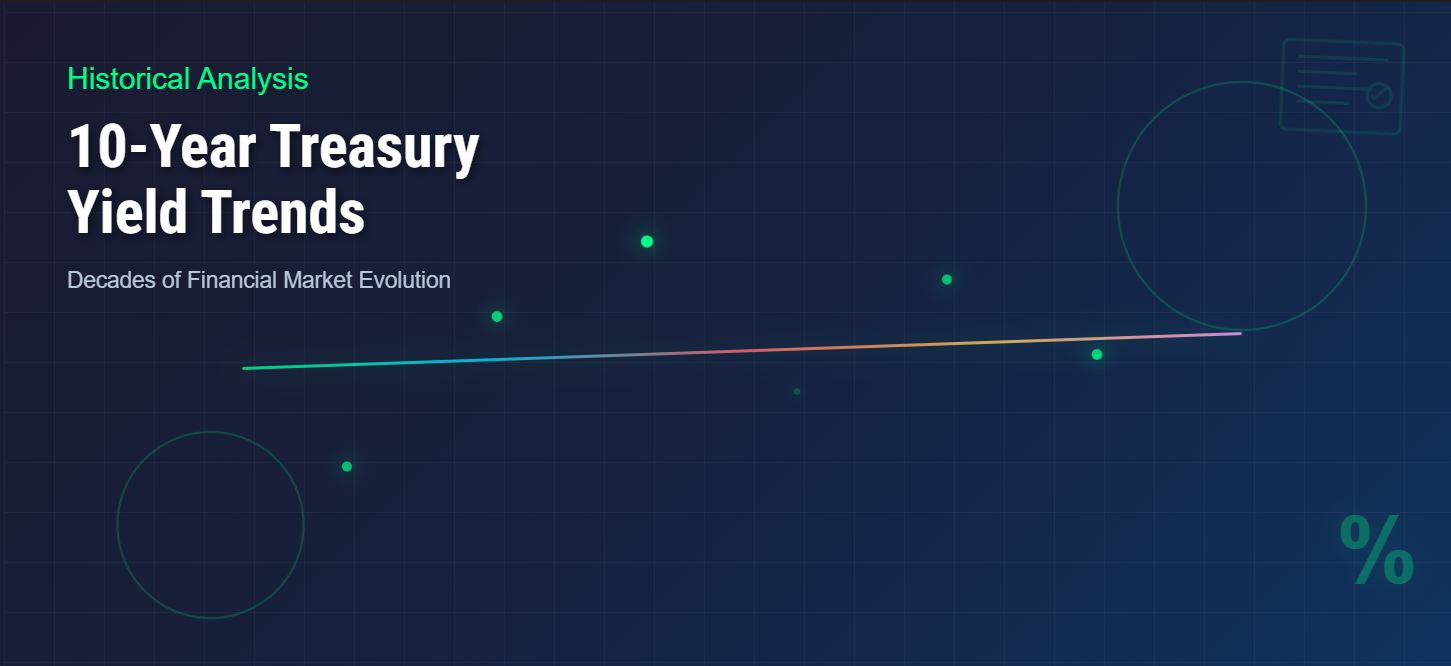The historical trends of the 10-year Treasury yield reveal a fascinating story of economic ups and downs, telling us a lot about how our economy has been doing over time. Simply put, the 10-year Treasury yield is a peek into how confident investors are about the future and how much they expect prices to rise. It's a key number that helps us understand where our economy might be headed, influenced by everything from government decisions to global events. I've spent a good amount of time digging into these numbers, and what I've found is that while they can swing quite a bit, they paint a pretty clear picture of our nation's financial journey.
What Are the Historical Trends of the 10-Year Treasury Yield?
Let's dive into how this important yield has behaved over the years. It’s more than just a number; it’s a reflection of societal shifts, policy changes, and the ever-present force of inflation. Understanding these trends can give us pretty valuable insights into economic cycles and what might be on the horizon.
The Rollercoaster Ride: Peaks and Valleys of the 10-Year Yield
If we look back, the 10-year Treasury yield has certainly not followed a straight line. It’s been more like a rollercoaster, with dramatic highs and lows that tell stories of different economic eras.
One of the most striking moments was in September 1981. The yield hit an astounding all-time high of about 15.82%. Now, why was it so high? Well, the country was really struggling with inflation – the kind where prices for everything just kept going up and up. To fight this, the Federal Reserve, which is like the country's central bank, started raising interest rates aggressively.
Think of it like this: when you raise interest rates, it becomes more expensive to borrow money, which usually slows down spending and, in turn, helps bring inflation under control. So, that super high yield was a direct response to a tough economic problem.
Fast forward a bit, and we see a completely different picture. Since the 1980s, there’s been a general trend of the 10-year yield going down. This decline became even more pronounced in recent years. During the COVID-19 pandemic in 2020, for instance, the yield dropped to multi-decade lows, even dipping below 1%.
This happened for a couple of big reasons. First, people were worried about the economy due to the pandemic, so they looked for safe places to put their money. Government bonds, like U.S. Treasuries, are considered very safe. Second, the Federal Reserve again stepped in, this time by lowering interest rates close to zero. This made borrowing super cheap and aimed to encourage spending and investment to support the economy during a difficult time.
The Past Decade: A Closer Look
Let's focus on the last ten years or so, say from 2015 to 2025. This period has been characterized by yields mostly hovering between 1.5% and 3.5%. It wasn't perfectly smooth, though. We saw brief bumps or spikes in yields when the economy was doing well and there were worries about inflation picking up. Conversely, yields dipped during times of economic slowdown or when there was global uncertainty, similar to how people seek safety when things are shaky.
Observing these recent moves, I’ve noticed a pretty clear pattern: yields tend to rise when the economy is heating up and inflation is a concern. When the Federal Reserve signals that it might increase interest rates to cool things down, yields usually follow. On the flip side, if there's a threat of recession or a major global crisis, yields often fall as investors pile into the perceived safety of long-term government debt.
Recent Movements and What They Mean
Looking at the most recent data, say around September 2025, the 10-year Treasury yield is around 4.14%. This might seem high compared to the pandemic lows, but it’s actually a bit below the long-term historical average, which has been hovering around 4.25% for many decades.
Just a year prior to this, in September 2024, the yield was closer to 3.73%. This upward movement indicates a trend driven by ongoing inflationary pressures and the Federal Reserve's efforts to tighten monetary policy – essentially, making borrowing more expensive to combat rising prices.
We've even seen the rate peak near 5% recently before pulling back a bit. This pullback happened as concerns about inflation started to ease, and the Federal Reserve began to hint at possible future rate cuts. This is a really interesting dynamic. When the Fed signals potential rate cuts, it means they think inflation might be under control or that the economy needs a bit of a boost. This often leads to a drop in longer-term yields as investors anticipate lower interest rates in the future.
Why Does the 10-Year Treasury Yield Matter So Much?
You might be wondering why I keep emphasizing the 10-year Treasury yield. Well, it's a really important benchmark for a lot of other interest rates in the economy.
Here’s a breakdown of the factors that commonly influence its movements:
- Federal Reserve Actions: The Fed's decisions on interest rates have a huge impact. When they raise rates, yields tend to go up, and when they cut rates, yields usually go down.
- Inflation Expectations: If investors expect prices to rise significantly in the future, they'll demand a higher yield to compensate for the loss of purchasing power of their money.
- Investor Demand for Safety: During times of economic uncertainty or fear, investors tend to buy more government bonds, which are considered safe havens. This increased demand can push prices up and yields down.
- Economic Growth: Strong economic growth often leads to higher yields as businesses and individuals borrow more, and investors expect higher returns.
- Global Economic Events: International events, like wars or financial crises in other countries, can also influence demand for U.S. Treasuries and, therefore, their yields.
Related Topics:
How Do Treasury Yields Impact Mortgage Interest Rates?
Mortgage Rates Predictions for the Next 12 Months: Sept 2025 to Sept 2026
Putting It All Together: A Historical Snapshot
To make it clearer, let’s look at a quick summary of some key historical points:
| Year/Period | 10-Year Yield | Key Context |
|---|---|---|
| 1981 (Peak) | 15.82% | Fed heavily fighting high inflation |
| 2020 (Pandemic) | <1% | Global recession, investors seeking safety |
| Sept 2024 | 3.73% | Rising inflation, Fed tightening monetary policy |
| Sept 2025 | 4.14% | Inflation persists, Fed signals future rate cuts |
| Long-term Avg | ~4.25% | Historical average since the 1960s |
As you can see from this table, the 10-year Treasury yield is a dynamic indicator. It’s not static; it moves and reacts to a lot of different forces. My personal take is that watching the 10-year yield is one of the best ways to get a feel for the overall health and expectations of the U.S. economy. It’s like listening to a heartbeat – subtle shifts can tell you a lot.
10-Year Treasury Yield Historical Trends
Key Historical Points and Economic Context
Key Historical Insights
15.82%
Fed fighting high inflation
<1%
Global recession, flight to safety
3.73%
Rising inflation, Fed tightening
4.14%
Persistent inflation concerns
~4.25%
Historical average since 1960s
In essence, the 10-year Treasury yield acts as a vital barometer, reflecting the intricate dance between monetary policy, the ever-present concern of inflation, and the collective sentiment of investors. By tracking these historical trends, we gain a deeper understanding of the economic forces that shape our financial world.
Capitalize Amid Rising Mortgage Rates
With mortgage rates expected to remain high, it’s more important than ever to focus on strategic real estate investments that offer stability and passive income.
Norada delivers turnkey rental properties in resilient markets—helping you build steady cash flow and protect your wealth from borrowing cost volatility.
HOT NEW LISTINGS JUST ADDED!
Speak with a seasoned Norada investment counselor today (No Obligation):
(800) 611‑3060
Also Read:
- Will Mortgage Rates Go Down in 2025: Morgan Stanley's Forecast
- Mortgage Rate Predictions 2025 from 4 Leading Housing Experts
- Mortgage Rate Predictions for the Next 3 Years: 2026, 2027, 2028
- 30-Year Fixed Mortgage Rate Forecast for the Next 5 Years
- 15-Year Fixed Mortgage Rate Predictions for Next 5 Years: 2025-2029
- Will Mortgage Rates Ever Be 3% Again in the Future?
- Mortgage Rates Predictions for Next 2 Years
- Mortgage Rate Predictions for Next 5 Years
- Mortgage Rate Predictions: Why 2% and 3% Rates are Out of Reach
- How Lower Mortgage Rates Can Save You Thousands?
- How to Get a Low Mortgage Interest Rate?
- Will Mortgage Rates Ever Be 4% Again?



